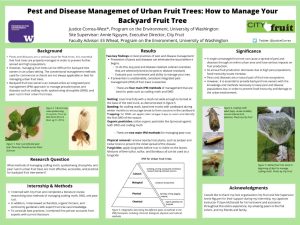Pest and Disease Management of Urban Fruit Trees: How to manage your backyard fruit trees
Pest and disease infestation in Seattle’s fruit trees is an increasing issue. This raises serious food insecurity concerns for local populations relying on the fruit harvested from urban fruit trees. When pest populations reach high levels, unmanaged fruit can become buggy and inedible, exacerbating issues of food justice that cannot be ignored. Because of this, it is vital that backyard fruit growers are provided with information, awareness, and methods of solving issues of pests and diseases in their urban fruit trees. My role in my internship at City Fruit was to research specific pests and diseases through a literature review. I also utilized interviews and talked with orchardists, organic farmers, and community gardeners to further understand this issue. The research culminated into two main findings: prevention of pests and diseases is key, and if prevention isn’t attainable, consistent management is vital for fruit tree health and resiliency. In this paper we will discuss management methods using an integrated pest management approach, which includes using cultural, physical, chemical, and biological barriers to manage pests and diseases. These different methods are important for backyard fruit tree owners to understand because pests and diseases can easily spread from one tree to another. If a single tree is improperly managed, it could infect an entire urban area, including commercial orchards that produce for many people. It is imperative to prevent this spread by educating owners on feasible management methods that can be utilized at the backyard scale of fruit production.
